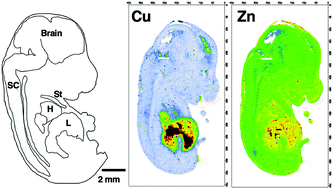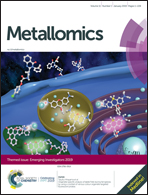Anatomical redistribution of endogenous copper in embryonic mice overexpressing SOD1
Abstract
Mutations in the copper (Cu)- and zinc (Zn)-binding metalloenzyme Cu/Zn-superoxide dismutase (SOD1) cause familial forms of amyotrophic lateral sclerosis (ALS), a fatal adult-onset neurodegenerative disorder of the central nervous system (CNS). Transgenic over-expression of mutant SOD1 produces a robust ALS-like phenotype in mice. Despite being ubiquitously expressed from the moment of conception, the mechanisms underlying the CNS-selective phenotype of mutant SOD1 expression remain poorly understood. We have previously shown that the physiological requirement for copper in SOD1 is unsatiated in the CNS of adult mice overexpressing mutant SOD1 and that suboptimal delivery of Cu to SOD1 in these mice progressively worsens with age. An age-related impediment to Cu availability may therefore contribute to the adult onset of disease in cases of ALS caused by mutant SOD1. Here, we have extended the age-related investigation of Cu in SOD1 overexpressing transgenic mice to the embryonic stage of development. We used the quantitative in situ elemental imaging method, laser ablation-inductively coupled plasma-mass spectrometry (LA-ICP-MS), to assess the endogenous distribution of Cu, Zn and other endogenous elements (carbon, phosphorus, sulphur, magnesium, manganese and iron) in the embryonic day 14 (E14) embryos of transgenic mice overexpressing wild-type human SOD1 (hSOD1Wt) or mutant human SOD1 (hSOD1G37R). We show that in contrast to adult mice, SOD1 overexpression (both wild-type and mutant) is associated with an overt redistribution of Cu from the liver to the CNS during embryonic development. Also in contrast to adult mice, Zn redistribution to the CNS in response to SOD1 over-expression is relatively modest in embryonic mice, being limited to the brainstem. No other elemental changes between genotypes were observed. Our application of quantitative LA-ICP-MS in situ imaging details the first anatomical mapping of endogenous elements in embryonic mice. The observed redistribution of Cu from the liver to the CNS in response to SOD1 overexpression during embryogenesis indicates that the impediment of Cu delivery to SOD1, which is evident in adult mutant SOD1 overexpressing mice, only occurs at a later stage in life.

- This article is part of the themed collection: Metallomics Emerging Investigators


 Please wait while we load your content...
Please wait while we load your content...